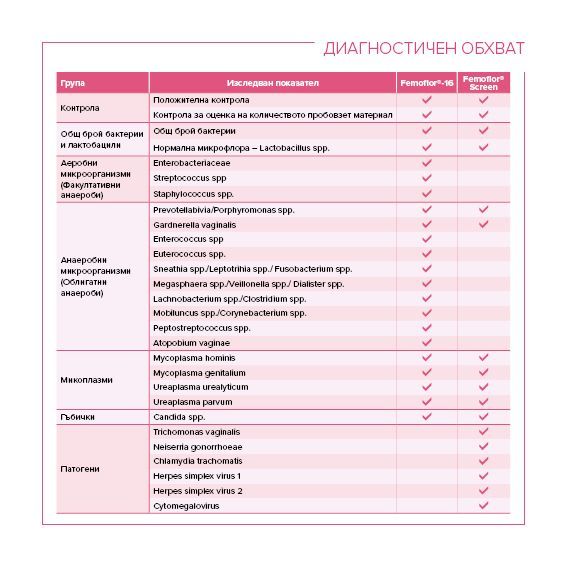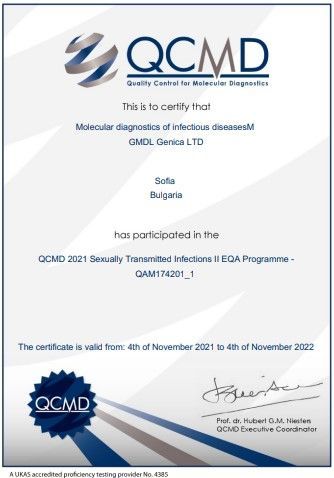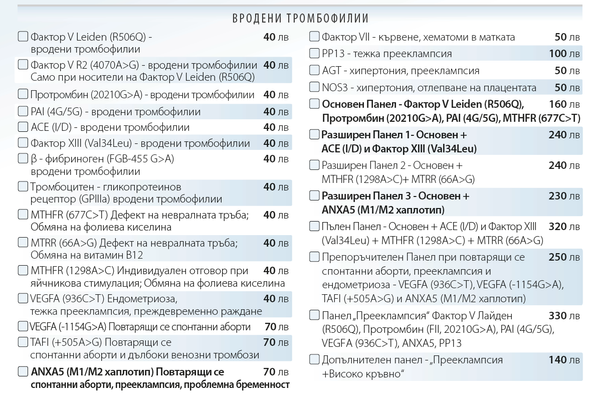Femoflor ®
Femoflor ® is a modern PCR-based test and the only diagnostic method that allows complex evaluation of vaginal microbiome composition, diagnosis of dysbiosis and detection of sexually transmitted infections. It is a first that with just one test is possible to determine the microbial vaginal composition in relation to all microorganisms inhabiting the female vaginal tract. Femoflor ® is the only test showing the full picture of the vaginal bacterial composition, distinguishing the norm from the disease. Bacterial vaginosis (BV) is a condition where certain bacteria predominate in the vagina. BV is associated with an imbalance of „good“ and „harmful“ bacteria, usually found in a woman's vagina. Bacterial vaginosis is the most common vaginal condition in women aged 15-44 years. Bacterial vaginosis is very often asymptomatic and can increase the risk of contracting sexually transmitted infections, as well as compromising intimate and reproductive health. Pregnant women are at increased risk of developing BV. Bacterial vaginosis during pregnancy is associated with a risk of miscarriage, premature birth, low birth weight and infection of the newborn. Treatment is especially important for pregnant women.
Diagnostic range: Lactobacillus spp., Enterobacterium spp., Streptococcus spp., Staphylococcus spp., Gardnerella vaginalis, Prevotella bivia, Porphyromonas spp, Eubacterium spp, Sneathia spp., Leptotrichia spp., Megasphaera spp., Veillonella spp., Dialister spp., Lachnobacterium spp., Mobiluncus spp., Corynebacterium spp., Clostridium spp., Peptostreptococcus spp., Atopobium vaginae, Ureaplasma urealyticum, Ureaplasma parvum, Mycoplasma hominis, Candida spp. , Mycoplasma genitalium, Fusobacterium spp
Diagnostic Method: Real-time PCR assay
Research Material: Vaginal swab
Results within: 1 business day
Fee: BGN 125
Clinical application
Diseases associated with bacterial vaginosis
Download Our Brochure
Femoflor Plus®
Femoflor plus® is a modern PCR-based test and the only diagnostic method that allows complex evaluation of vaginal microbiome composition, diagnosis of dysbiosis and detection of sexually transmitted infections. It is a first that with just one test is possible to determine the microbial vaginal composition in relation to all microorganisms inhabiting the female vaginal tract. Femoflor ® is the only test showing the full picture of the vaginal bacterial composition, distinguishing the norm from the disease.
Diagnostic Range: Lactobacillus spp., Enterobacterium spp., Streptococcus spp., Staphylococcus spp., Gardnerella vaginalis, Prevotella bivia, Porphyromonas spp, Eubacterium spp, Sneathia spp., Leptotrichia spp., Megasphaera spp., Veillonella spp., Dialister spp., Lachnobacterium spp., Mobiluncus spp., Corynebacterium spp., Clostridium spp., Peptostreptococcus spp., Atopobium vaginae, Ureaplasma urealyticum, Ureaplasma parvum, Mycoplasma hominis, Candida spp. , Mycoplasma genitalium, Fusobacterium spp, Chlamydia trachomatis, Trichomonas vaginalis, Neisseria gonorrhoeae
Diagnostic Method: Real-time PCR assay
Research Material: Vaginal and cervical specimen
Results within: 1 business day
Fee: BGN 187
Diseases associated with the range of Femoflor plus®
Vaginitis; Cervicitis; Predisposition to sexually transmitted infections; Pelvic inflammatory disease; Infertility; Spontaneous abortions; Premature birth; Neonatal infection
Download Our Brochure
Download Our Brochure
Androflor®
Androflor® is the only complex test for determining the clinically significant concentration of all microorganisms inhabiting the male urogenital tract. Infections in the male urogenital tract are a global problem and are gaining ever more social and economic significance.
Urogenital infections are the most common cause of reproductive dysfunction in men and a major factor in infertility development. Acute and chronic infections damage the germinal epithelium of the testicles, disrupt spermatogenesis, and impair the quality of semen. The lack of symptoms is the reason infections go unnoticed and transmitted to the sexual partner.
Diagnostic Range: ACE
Diagnostic Method: Real-time PCR assay
Research Material: Urine / Ejaculate
Results within: 1 business day
Fee: BGN 197
Diseases associated with the range of Androflor®
Urethritis; Enlarged prostate; Acute prostatitis; Chronic prostatitis; Orchitis and epididymitis; Balanitis; Inflammation of the seminal ducts; Inflammation of the spermatic cord, tunica vaginalis and vas deferens; Secondary infertility
Download Our Brochure
Chromosome Analysis
Chromosome analysis or karyotyping is a genetic test that evaluates the number and structure of a person's chromosomes in order to detect abnormalities.
Diagnostic Range: Chromosome abnormalities
Diagnostic Method: Cytogenetic analysis
Research Material: Venous blood in heparin (green tube)
Results within: 40-60 days
Fee: BGN 300
Clinical application
Reproductive failures
FERTILITY TEST®
The FERTILITY TEST® allows for the detection of direct bacterial and viral activity, associated with the development of infections causing infertility.
The FERTILITY TEST® allows the diagnosis of genital viral and bacterial infections inhabiting the endometrium without the need for invasive interventions. The integration of FERTILITY TEST® is recommended in routine gynecological screening tests to ensure comprehensive diagnosis and treatment of the infection before serious side effects from undetected infections occur. The FERTILITY TEST® is the right choice in the diagnosis of endometritis and pelvic inflammatory disease (PID), oligospermia, asthenospermia and teratospermia, unclear sterility.
Diagnostic Range: Herpes family HHV-1 to -8 (HSV-1, HSV-2, CMV, EBV, VZV, HHV-6, HHV-7, HHV-8) and Chlamydia trachomatis, Ureaplasma urealyticum, Ureaplasma parvum, Mycoplasma hominis, Mycoplasma genitalium, Neisseria gonorrhoeae, Trichomonas vaginalis, Gardnerella vaginalis
Diagnostic Method: PCR Assay
Research Material: Menstrual tissue / Ejaculate
Results within: 5 business days
Fee: BGN 250
Clinical application
Gynecological prophylaxis, endometritis, pelvic inflammatory disease (PID), oligospermia, asthenospermia and teratospermia, unclear sterility
Download Our Brochure
Chlamydia
Chlamydia is a common STD that can infect both men and women. It can cause serious, permanent damage to a woman's reproductive system. This can make it difficult or impossible for her to get pregnant later on. Currently, PCR assay is the gold standard for the diagnosis of chlamydial infections (See the diagnostic recommendations of the Centers for Disease Control and Prevention HERE).
Diagnostic Range: Chlamydia trachomatis
Diagnostic Method: PCR Assay
Research Material: Cervical sample / Endometrial menstrual tissue / Urine / Ejaculate /
Results within: 1 business day
Fee: BGN 35
Diseases associated with chlamydial infection
Cervicitis; Urethritis; Epididymitis; Prostatitis; Premature birth; Pelvic inflammatory disease; Ectopic pregnancy, Infertility; Spontaneous abortions; Newborn infections
Download Our Certificate
Congenital Thrombophilia
This test analyzes genetic factors related to disorders of the coagulation system and the risk of increased blood clotting, as well as the risk of hypofibrinolysis.
Indications for the test are one or more miscarriages in the family, stillbirth, fetal growth retardation, preeclampsia, preparation for an in vitro procedure, use of hormonal contraceptives, varicose veins, cardiovascular disease in the family.
Number of Markers Tested:: 16
Polymorphisms Included: : Blood coagulation factors: FVL (R506Q), FII 20210G> A, FVII p.R353Q, FXIII p.V34L, FGB c.455G> A Fibrinolysis: PAI 4G / 5G, GPIIIa c.155T> C, TAFI c.505A> G Folate cycle: MTHFR c.77C> T, c.1298A> C, MTRR c.6A> G Other factors: ANXA5, VEGFA c.936C> T, c.-1154G> A, PP13, ACE (I / D)
Research Material: Venous or capillary blood with K2EDTA (purple tube)
Results within: 5-10 business days
Fee: BGN 40 - BGN 330, depending on the prescribed combination of polymorphisms
Diseases and Conditions
Family history of miscarriage ; Stillbirth; Fetal growth retardation; Preeclampsia; Preparation for in vitro procedure; Use of hormonal contraceptives; Varicose veins; Family history of cardiovascular diseases
Download Our Brochure
Gonorrhea
Gonorrhea is a sexually transmitted disease (STD) caused by infection with the Neisseria gonorrhoeae bacterium. It can infect both men and women and is transmitted through vaginal, anal and oral sexual contact with an infected partner.
Gonorrhea is a very common infectious disease especially among young people aged 15-24. It can affect the genitals, rectum, and throat, depending on sexual practices.
Untreated gonorrhea can cause serious and permanent health problems in both women and men. The infection can also be spread perinatally from mother to baby during childbirth.
Currently, PCR analysis is the gold standard for the diagnosis of gonococcal infections (See the diagnostic recommendations of the Centers for Disease Control and Prevention HERE).
Diagnostic Range: Neisseria gonorrhoeae
Diagnostic Method: PCR Assay
Research Material: Cervical sample / Endometrial menstrual tissue / Urine / Ejaculate /
Results within: 1 business day
Fee: BGN 35
Diseases associated with gonorrhea
Cervicitis; Urethritis; Epididymitis; Prostatitis; Premature birth; Pelvic inflammatory disease; Ectopic pregnancy, Infertility; Spontaneous abortions; Newborn infections
Download Our Certificate
Premature Ovarian Failure
Premature ovarian failure (POF)— also called Primary ovarian insufficiency (POI) - occurs when the ovaries stop functioning normally before age 40. POF is one of the main causes of infertility in women. In 1-2% of them, POF is observed before the age of 40 and about 0.1% before the age of 30.
POF can be appear very early as a defect in puberty. Depending on the age of occurrence the disorders can manifest as primary amenorrhea (PA), without a first menstrual cycle (menarche) or secondary amenorrhea after puberty. The etiology of POF is highly heterogeneous with 12% of cases being chromosomal abnormalities. Family history is very common.
Diagnostic Range: NR5A1, BMP15, FMR1, FSHR, GNRHR, NOBOX и FIGLA
Diagnostic Method: Sanger sequencing
Research Material: 3-6 ml venous blood/peripheral blood
Results within: 10 business days
Fee: FMR1 - BGN 150; FOXL2 - BGN 250; FIGLA - BGN 300; BMP15 - BGN 300; NOBOX - BGN 600.
Clinical application
Premature ovarian failure; Genetic predisposition; Reproductive failures
Spermogram
Semen analysis, also known as spermogram, is a test that evaluates certain characteristics of a male's semen and the sperm contained therein.
To perform a semen analysis, it is necessary for semen to be provided in a specially designed sterile container. It must be submitted for lab testing no more than half an hour after ejaculation.
Diagnostic Panels: Semen analysis; Extended semen analysis; Postcoital test; Sperm DNA fragmentation
Special Test Requirements: Avoid sexual contact – at least 3 days before the test; Avoid alcohol; Avoid excessive smoking
Research Material: Ejaculate
Results within: 2 hours
Fee: From BGN 50 to BGN 450, depending on the diagnostic panel selected
Clinical application
Reproductive failures
Microdeletions on the Y Chromosome
The test is an analysis for the presence of microdeletions on the Y-chromosome, related to disorders in spermatogenesis.
Diagnostic Range: AZFa, AZFb, AZFc, SRY
Diagnostic Method: PCR
Research Material: Venous or capillary blood with K2EDTA (purple tube)
Results within: 5-10 business days
Fee: BGN 160
Clinical application
Azoospermia
Ovarian Hyperstimulation Syndrome
Ovarian hyperstimulation syndrome (OHSS) is a serious complication of ovulation induction that usually occurs after chorionic gonadotropin administration or in vitro procedures in infertile patients. It is characterized by bloating, enlarged ovaries, and increased vesicular permeability. Severe OHSS is accompanied by massive ovarian enlargement, ascites, pleural effusion, oliguria, hemoconcentration, and thromboembolism.
Certain genetic changes lead to ovarian hyperresponsiveness to circulating levels of follicle-stimulating hormone (FSH) or to hormones with a similar FSH structure such as hCG or thyroid-stimulating hormone (TSH). This can lead to spontaneous OHSS.
There is a genetic variation that is associated with a different response in controlled ovarian hyperstimulation (ovarian response to FSH). That is important for determining controlled ovarian stimulation cycles in women of childbearing potential.
Diagnostic Range: FSHR
Diagnostic Method: Sanger sequencing
Research Material: 3-6 ml venous blood / 2 ml peripheral blood
Results within: 5 business days
Fee: BGN 50 - one mutation / BGN 250 - full panel
Clinical application
Obstetrics and Gynecology; Genetic predisposition; Reproductive failures






